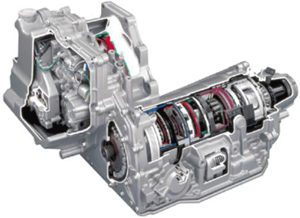
An example of a Jaguar front-engine, all-wheel-drive layout where the rear output shaft of a transmission goes on to power a center transfer case, which splits power to separate front and rear axle differentials. While this powertrain is full-time all-wheel-drive, part-time 4-wheel-drive vehicles use this same basic layout – varying only in differential function.
In this article we’ll look at the differences between a “transaxle” and a “transmission”. In short, a transaxle performs both the gear-changing function of a transmission and the power-splitting ability of an axle differential in one integrated unit. A transmission performs the gear-changing function only, delivering power via a single output shaft at the back of the unit. Although both perform gear shifts in the same fashion, there’s often confusion about these two terms because the word “transmission” is sometimes used as a blanket description to include transaxles when it should not be.
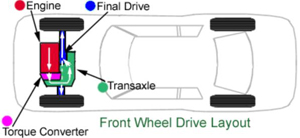
This diagram shows a typical front-wheel-drive layout with a transaxle that performs both the gear-changing function of a transmission and the power-splitting ability of a differential in one integrated unit.
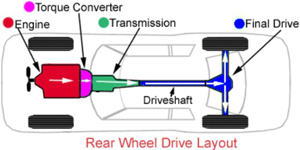
This diagram shows a typical rear-wheel-drive layout with a transmission that performs the gear-changing function only, delivering power via a single driveshaft to a separate differential unit on the rear axle.
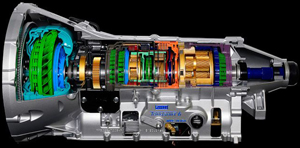
A closer look at a typical “transmission” designed to mount directly behind an engine. While it routes power from the engine through gears of various ratios, a single driveshaft exits the rear. Transmissions are not designed to be mounted in between left- and right-side axle shafts the way a transaxle assembly is.
More specifically, looking up the word “transmission” in any number of locations brings similar yet varying descriptions when it comes to automotive applications. Some authoritative sources refer to a transmission vaguely as “an enclosed unit of gears that transmits power from the engine to the driving wheels of a motor vehicle.” In theory, that also sounds like what a transaxle does. Other descriptions are more detailed – specifying an enclosed unit which transmits power from the engine’s crank shaft to the drive shaft that leads to a vehicle’s drive wheels. No definition of a transmission actually mentions an ability to split torque to two different axles while being located directly between them. Also, the presence of a drive shaft mentioned confirms there is also a separate differential located elsewhere that splits power in the middle of an axle.
Look up “transaxle” and in every case, you’ll find a definition that clearly spells out an integrated component which combines the gear-changing function of a transmission with the power-splitting ability of a differential. There is no single driveshaft exiting a transaxle, because there is no separate differential unit located elsewhere to receive it. Instead, shafts for both the left- and right-side drive axles themselves are directly connected to each side of the transaxle. While they may be separated, transmission cogs and differential gears are contained within one large transaxle housing.
Transmissions are mostly found in cars and trucks designed with a front-engine, rear-wheel-drive layout. In such vehicles both the transmission and engine will be mounted front-to-back rather than sideways. Part-time four-wheel-drive drivetrains found in pickups and sport utilities usually feature this same layout – adding a separate, self-contained transfer case to direct power to front and rear axles via a separate set of drive shafts. Many full-time all-wheel-drive vehicles feature the same design – however some all-wheel-drive setups based on front-wheel-drive platforms will have a transaxle setup for the front wheels and a separate shaft running to the rear axle.
In two-wheel-drive vehicles, transaxles are found in all configurations where the engine is located at the same end of the vehicle as the drive wheels are. This includes front-engine/front-wheel-drive layouts as well as rear-wheel-drive layouts with an engine behind the passenger cockpit. Vehicles with the engine mounted behind the rear axle line are known as “rear engine” models, while vehicles with the engine behind the driver but in front of the rear axle line are known as “mid engine” models.
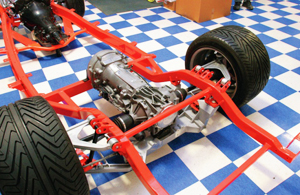
This picture of the rear of a late-model Corvette allows a good look at the layout of a front engine, rear-wheel-drive vehicle with a transaxle integrated into the rear axle.
Another popular layout on front-engine, rear-wheel-drive vehicles oriented for performance is a transaxle that’s integrated into the rear axle. Benefits of this design include more even front/rear weight distribution to enhance handling, and the absence of a separate differential unit reduces overall vehicle weight. Because the driveshaft from the engine to the rear axle spins at faster engine rpm rates, it’s encased within a protective metal tube. Notable vehicles that feature this setup include Corvettes from 1997-on, Porsche 924/944/968 and 928 models from the 1970s through the 1990s, various front-engine Ferraris from the 1960s through today, various Alfa Romeos from the 1970s through the 1990s, 2003-on Aston Martins, and a variety of automobiles built for other world markets.
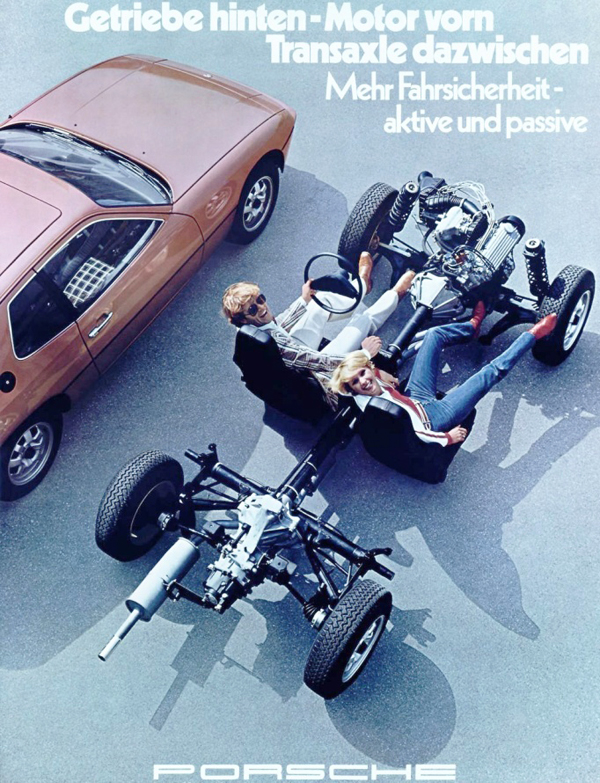
This German-market advertisement introducing the 1977 Porsche 924 highlights the model’s front engine, rear transaxle layout.
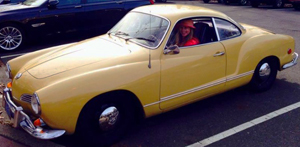 Notable rear-engine vehicles with a rear transaxle include original Volkswagen Beetles, Karmann Ghias and all derivative models sold in the United States through the 1970s, Chevrolet Corvairs from 1960-69, Porsche 356 and 911 models from the 1940s through present day, and 1980s DeLorean sports cars.
Notable rear-engine vehicles with a rear transaxle include original Volkswagen Beetles, Karmann Ghias and all derivative models sold in the United States through the 1970s, Chevrolet Corvairs from 1960-69, Porsche 356 and 911 models from the 1940s through present day, and 1980s DeLorean sports cars.
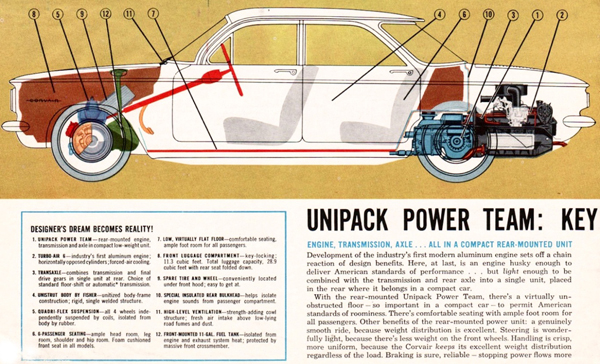
This diagram of a 1960 Chevrolet Corvair gives a closer look at its rear-engine placement behind the rear axle line, and its rear transaxle.
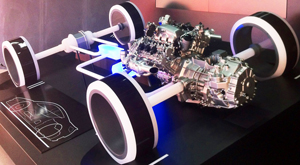
This mockup of a 1991 Acura NSX powertrain allows a good look at a mid-engine, rear-wheel-drive layout with a rear transaxle. Notice how the mid-engine design places the engine behind the driver but ahead of the rear axle line.
Notable vehicles with a mid-mounted engine and a rear transaxle include a variety of Ferraris from the 1970s through today, Toyota MR2s from the 1980s through the early 2000s, modern Lotus offerings, Lamborghinis from the 1970s through today, 1980s Pontiac Fieros, Ford GT40s, Acura NSXs, and most low-volume supercars of various origins throughout the world built during the last 40+ years.

